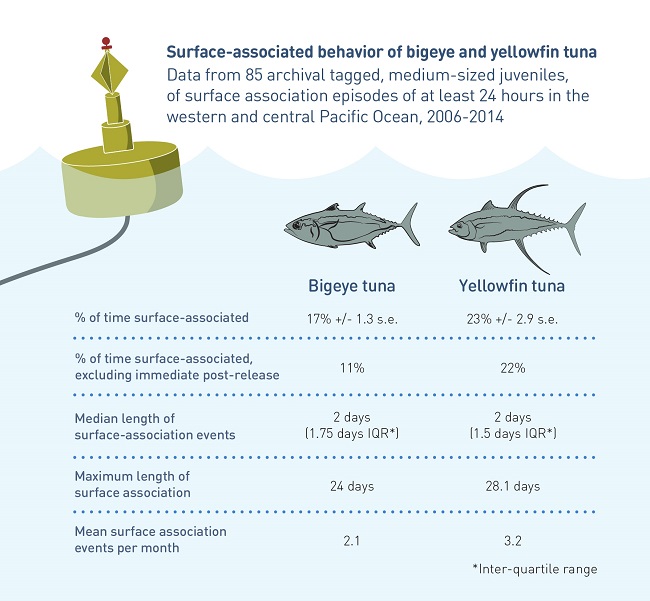Surface Association in Juvenile Bigeye and Yellowfin Tuna is Brief, Tagging Data Suggest
Study argues effort limits on FADs may be more effective than seasonal closures
Most visits to surface waters by medium-sized juvenile yellowfin and bigeye tuna are brief, according to a new study of electronic tagging data from the western and central Pacific Ocean. This finding suggests that limits to fishing effort on FADs (fish aggregating devices) may be necessary as part of any strategy to prevent overfishing of these species, and that seasonal closures will be relatively ineffective.
Introduction
In the Pacific, fishing for skipjack tuna using FADs results in significant bycatch of juvenile bigeye and yellowfin tuna, which often school with skipjack. Bigeye tuna are considered overfished in the region, and juvenile bycatch is a concern even for species that do not appear overfished, such as yellowfin (ISSF 2017).
Tuna often associate with logs and other natural floating objects, for reasons that are not entirely clear. The “ecological trap theory” proposes that FADs are different from these natural objects because tuna become associated with them for prolonged periods, leading the tuna to move to or remain in locations that may not be favorable (Marsac et al. 2000). This could make them more vulnerable to fishing, alter their migration, reduce their food supply, or increase their exposure to predators.
To explore the FAD-related behavior of bigeye and yellowfin tuna, an international research team, led by Dr. Joe Scutt Phillips at the University of New South Wales, assessed the duration of surface associations in these species.
Methods
The study (Scutt Phillips et al., 2017) looked at data from 50 bigeye and 35 yellowfin tuna fitted with archival tags as part of the Pacific Tuna Tagging Program. At least 30 days of data were available for each individual between release and its recapture by a fishing vessel. Archival tags record swimming depth, external water temperature, and ambient light level, allowing researchers to reconstruct vertical movements with high precision, and latitude and longitude with lower precision.
The researchers used these data to estimate the duration of every extended visit to the surface. They classified visits that lasted for at least 24 hours as “surface-association behavior,” a pattern typical of association with a floating object. The data did not allow them to link individual visits to the presence or absence of FADs. However, they did estimate the frequency of surface-association in regions of differing FAD density, as measured by the number of FAD sets by vessels fishing for tuna.
Results and implications
Episodes of surface association lasted for a median of two days in both bigeye and yellowfin tuna. This is a relatively brief period, although much longer visits were observed (see details in Table 1). Total time spent in surface association was also relatively short—17 percent for bigeye and 23 percent for yellowfin. Areas with higher FAD density did not show any increase in surface association.
This result shows that the long-term surface associations posited by the ecological trap theory are not common in this region. That suggests that the main effect of FADs on bigeye and yellowfin tuna is to make aggregations containing these species easier to locate and catch. In that case, the only way to reduce their bycatch would be to reduce fishing effort on FADs, the authors argue.
Seasonal FAD closures, which are common in the western and central Pacific and elsewhere, would have limited effect unless they also reduced total FAD effort or occurred during times of particularly high bycatch. Other studies corroborate this, showing that some closures do not reduce catch or effort, but simply shift effort on FADs from one place or time to another (e.g. Pilling et al. 2011). Taken together, these findings suggest that overall limits on the number of FAD sets could be a more effective tool to conserve bigeye and yellowfin tuna.
Citations
International Seafood Sustainability Foundation. (2017). Status of the world fisheries for tuna. ISSF Technical Report 2017-02. International Seafood Sustainability Foundation, Washington, D.C., USA.
Marsac F., Fonteneau, A., & Menard, F. (2000). Drifting FADs used in tuna fisheries: an ecological trap? In: Le Gall, J.-Y., Cayre, P. & Taquet, M. (eds), Pêche thonière et dispositifs de concentration de poisons. Ed. Ifremer, Actes Colloq. 28, 537-552.
Pilling, G., P. Williams, J. Hampton, & S. Harley. (2013). Analysis of the implementation and effectiveness of key management measures for tropical tunas. Western and Central Pacific Fisheries Commission Scientific Committee. Ninth Regular Session, 1–24.
Scutt Phillips, J., G. M. Pilling, B. Leroy, K. Evans, T. Usu, C. H. Lam, K. M. Schaefer, & S. Nicol. (2017). Revisiting the Vulnerability of Undersized Bigeye (Thunnus obesus) and Yellowfin (T. albacares) Tuna Caught by Purse-seine Fisheries while Associating with Surface Waters and Floating Objects. PLOS ONE. In press.


